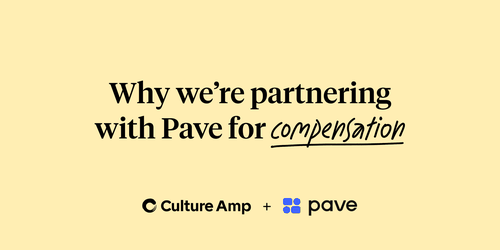
How to build a compensation plan that drives performance

Compensation and performance are intertwined, but their relationship is more complex than it looks at first glance. While a high salary may initially attract a candidate’s interest, driving continued performance and productivity requires a more nuanced compensation strategy.
Erica Pachmann, Senior People Scientist at Culture Amp, and Alexis Joseph Merritt, VP of People at Pave, a category-leading compensation management software company, teamed up for a webinar to help companies optimize their compensation planning. They offered guidance on everything from establishing a compensation philosophy to designing competitive compensation packages.
Four steps for creating an effective compensation strategy
1. Start with a compensation philosophy
A compensation philosophy is a set of guidelines for how your organization compensates employees. Alexis recommends that if your company doesn’t already have a compensation philosophy in place, you create one. The document will serve as a "North Star" to guide all of your company's compensation decisions.
She says, "This is a crucial first step, because it helps your people on HR teams, helps your executives, your executive sponsors, and your managers all clarify that 'why' behind pay, and also helps create a framework to make sure there's consistency across a team, a company, or business."
A compensation philosophy allows the company to be proactive, instead of reactive, around compensation. It also provides transparency into how the company makes these decisions, making the process more consistent – and more equitable.
Tip: Putting your compensation plan in writing shows employees that you’re using specific criteria to build your compensation packages and that you’re making these decisions fairly. That can have a resounding impact. Erica explains, “Perceptions of organizational justice can really affect employee outcomes such as motivation, trust, engagement, satisfaction, performance, and turnover.”
2. Take a holistic approach to compensation
When creating compensation packages, think about what will benefit both the employee and the company, short-term and long-term. Consider including not only direct compensation and indirect compensation but also non-monetary compensation such as recognition programs. Erica says, “That holistic, more inclusive package is really going to be the best way for you to increase your engagement and also keep your top performers within the organization.”
Let’s take a closer look at these three elements.
-
Direct compensation
Direct compensation refers to salary, commission, variable pay, and bonuses – all the things people think of first when they think of compensation. While direct compensation is often the primary way companies get talent in the door, it’s not the driving factor for why people stay at an organization. Erica says, “Once they’re in your organization, that’s not going to be the thing that keeps them engaged and motivated.”
To explain this, she brings up the concept of hedonic adaptation, the idea that the increased happiness someone feels after a positive event doesn’t last very long. For example, after receiving a salary increase, an employee will soon return to their usual level of happiness.
Instead of relying on monetary compensation to drive performance, Erica says, “you're going to want to have intermittent feedback and recognition throughout to keep your employees motivated and engaged.” -
Indirect compensation
Indirect compensation describes the benefits your company offers employees, including health insurance, disability benefits, paid time off, paid educational support, and support for parents and caretakers. Alexis says, “There’s so much that goes into this that we have to be exceptionally thoughtful about.”
As you decide on the best mix of benefits for your company, she says, “It’s going to be crucial to make sure that your employees actually understand what it entails and how it all comes together.”
Communicating the value of your benefits helps employees feel that they’re being compensated fairly and competitively, which Alexis explains “is going to help significantly with things like employee happiness and retention.” -
Non-monetary compensation
Non-monetary compensation goes beyond the typical benefit offerings, including employee recognition, mentorship, and skills development in compensation packages.
Erica says that once the basic need for monetary compensation is met, other intangible expectations become much more important to employees. “These are the things that translate into feeling respected and acknowledged in their work, and being able to build upon their competencies and also find meaning and reward in their work.”
Tip: Look for ways to incorporate flexibility into your rewards and recognition programs, because people have different needs, drivers, and motivators. When your programs are flexible, you can tailor them based on what works best for the individuals in your workforce. For example, not everyone appreciates the same type of recognition, so it makes sense to provide a variety of ways for leaders to recognize employees.
3. Integrate data into your compensation packages
To ensure managers across your company are equipped to offer competitive, fair, and unbiased compensation packages, provide a framework that shows them how to leverage relevant data. Alexis points out, “It's really challenging to make decisions if you don't have confidence in your data, or if you don't have data.”
If you’re looking for specific benchmarks that align with your company size and employee locations, you don’t have to do the research on your own. Existing tools make it easy to access this information. For example, Culture Amp recently partnered with Pave so that our customers have the data points they need to make equitable decisions around compensation. This partnership helps companies attract and retain talent while also reducing costs.
When you create compensation plans based on trustworthy data, you’ll feel more confident in your decisions and be able to justify them to employees and stakeholders.
4. Communicate your compensation strategy to employees
As your company defines its compensation structure, be transparent with employees about why you made the decisions that you did. Erica believes that when companies don’t do this, it’s a missed opportunity that “really impacts the level of perceived fairness that exists within an organization.” Being open and clear about compensation helps to build trust.
Transparency around compensation involves not only listing pay ranges in your job descriptions to attract qualified candidates but also making sure your current employees understand where they fall in their salary band – and what they need to do to get to the next level. Sharing this information can help employees feel respected, valued, and motivated. If your company takes a continuous approach to performance management, you can discuss the company’s compensation plan as part of your regular feedback and coaching conversations.
You’ll also want to be transparent about the fact that the compensation strategy will evolve over time along with the company. Alexis says, “It’s an ongoing process, and we have to be able, as people leaders, to iterate.”
Thoughtful compensation planning pays off
Concerned that establishing a compensation philosophy or creating strategic guidelines around compensation will lead to cookie-cutter compensation packages? Don’t be. Managers will still have the ability to bring what they know about the individual into the decision-making process – and they’ll be doing it in a more equitable and transparent way.
When you create a holistic, data-backed compensation plan and clearly communicate to your team how compensation decisions are made, you’re creating a culture of trust. When people understand how they will be compensated and recognized for their work, they feel inspired to perform their best.

Dive deeper into creating a compensation philosophy
Learn how to attract talented candidates and motivate employees with an effective compensation strategy.





